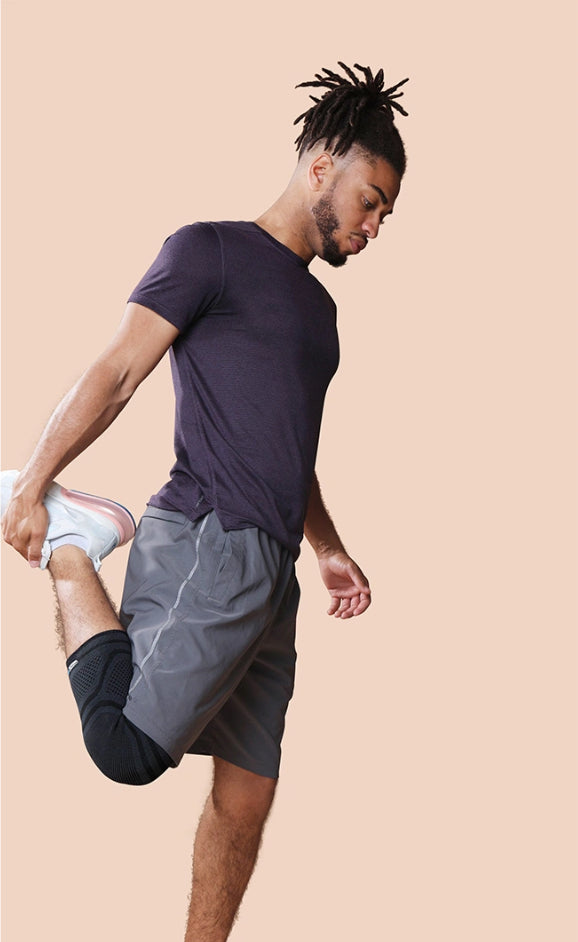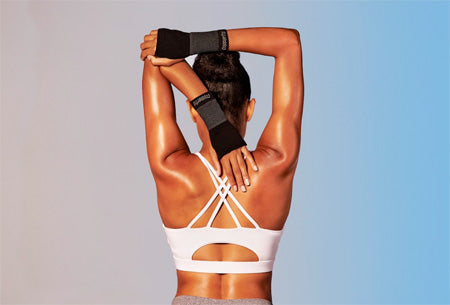
Feeling sore or tight in the elbow when you bend or straighten your arm is more common than you might think. Whether it shows up after a workout, a long day of typing, or a weekend of home projects, that discomfort can get in the way of daily routines and workouts alike.
When your elbow isn’t moving the way it should, even simple tasks like lifting a grocery bag or pushing up off the floor can become frustrating. You don’t have to be an athlete to deal with this kind of tension.
The elbow is involved in almost every upper-body movement—pulling, lifting, reaching, twisting. So, when it starts to feel off, it’s a sign your body may need some recovery time or a few smart adjustments to your routine.
Let’s take a look at what that discomfort actually is, what causes it, and how to support your elbow so you can stay active and feeling your best.
What Does Elbow Discomfort Feel Like?
Discomfort in the elbow doesn’t always come on strong. It often starts with a dull ache or a sense of tightness when you bend or extend your arm.
You might notice it more during certain tasks—gripping a weight, picking up a grocery bag, doing push-ups, or even typing for long periods. Over time, that minor ache can shift into something that lingers, making it harder to stay consistent with your routines.
The sensation can vary depending on what’s causing the tension. Some people feel it mainly when straightening the arm; others notice it when flexing. In many cases, the discomfort feels worse after repetitive motion, especially when those movements involve gripping, twisting, or putting weight on the elbow.
If you’re experiencing soreness that eases with rest and returns with activity, it’s often a sign that the area is under strain and needs support—whether that’s better recovery time, improved form, or a more structured warm-up and cooldown.
What Are Common Causes of Elbow Discomfort?
Your elbow is made up of bones, tendons, ligaments, and muscles that all work together to create smooth, controlled movement. When one part of that system gets overworked, tight, or irritated, it can create discomfort during motion.
Here are a few common reasons this happens:
1. Repetitive Motion and Overuse
Repeating the same movement—especially in activities that involve straightening and bending the elbow such as weightlifting, tennis, golf, or even using tools—can put consistent strain on the muscles and tendons around the elbow. This overuse can build up tension in the tissue, which can lead to soreness that sticks around if you don’t give the area time to recover.
2. Improper Technique
Using incorrect form during exercise is a big contributor to elbow discomfort. Whether it’s poor alignment in a push-up or holding weights the wrong way during curls, these small misalignments add up over time. The stress can shift to areas that aren’t meant to handle the load, leading to irritation and strain in the elbow joint.
3. Sudden Changes in Activity Level
Jumping into a new fitness routine with high intensity—without giving your body time to adjust—can increase your risk of elbow tension. Muscles and connective tissues need time to adapt to new levels of strain. Going too hard or fast, especially in upper-body workouts, often leads to stiffness or soreness the next day.
4. Age-Related Changes
As we get older, the structures that support our joints naturally become less elastic. That includes the tendons and ligaments around the elbow. This doesn’t mean discomfort is inevitable—it just means the body may take longer to recover or require more intentional support to stay strong and mobile.
5. Cold, Tight Muscles
If you’re working out or performing repetitive tasks in cold environments, the muscles and tendons in your elbow may not be as flexible. This can increase the chance of tightness or discomfort when you start moving.
Taking a few minutes for a solid warmup routine before heading out into the cold can help loosen the muscles, and make sure you dress appropriately for the weather to help limit the risk of weather-related tension.
When To Pay Attention to Your Symptoms
Some soreness is normal, especially after a new workout or activity. But it’s important to know when that soreness crosses the line into something that needs more attention.
You should slow down and reassess if you’re experiencing:
- A sharp or stabbing sensation during movement
- Swelling or visible changes in the elbow area
- Weakness when gripping objects
- Discomfort that doesn’t improve with rest
While general tension can often be managed with recovery strategies and ergonomic adjustments, persistent or worsening symptoms should be looked at by a healthcare professional. Taking early action is key to staying active and avoiding longer-term setbacks.
Everyday Movements That Can Contribute to Elbow Tension
You don’t have to be an athlete to experience elbow discomfort. Everyday movements can add up—especially if they’re repeated frequently or done with poor posture.
- These are a few common activities that can stress the elbow joint, such as:
- Working at a computer or using a mouse for hours at a time
- Carrying heavy bags or lifting kids, pets, or groceries
- Doing household tasks like scrubbing, raking, or drilling
- Fitness exercises that involve gripping, pulling, or pushing
The key isn’t to stop doing these activities—it’s to support your elbow before, during, and after them. A few simple tweaks to your routine can go a long way in helping your body recover and perform its best.
How Can I Support Elbow Recovery?
When you start to feel discomfort in your elbow, it doesn’t mean you have to stop moving entirely. In fact, staying gently active can often support your recovery—if you’re mindful about how you move.
Let’s walk through practical, effective strategies that can help soothe tension, support your range of motion, and promote recovery—while keeping you in motion.
1. Prioritize Rest and Recovery Time
It sounds simple, but one of the most powerful tools for easing discomfort is rest. Giving your elbow a break from repetitive stress can allow it to reset. If you’ve been lifting weights, swinging tools, or gripping tightly during activity, taking a few days off from those specific movements can help build up strength and reduce soreness.
During that time, focus on other activities that keep your body moving without aggravating the joint—like walking, gentle core work, or mobility-focused exercises that avoid pressure on the elbows.
Use Hot or Cold Therapy
Hot and cold therapy can be great tools to help soothe discomfort—if used the right way. For soreness or tightness that comes on after a tough workout or long day of activity, cold therapy may help reduce tension when applied shortly after the strain.
On the other hand, if you’re dealing with stiffness that’s been building over time, applying heat can help relax the surrounding muscles and promote easier movement. Be consistent but cautious. Never apply extreme temperatures directly to the skin, and give your body breaks between applications to avoid irritation.
Add Gentle Stretching and Mobility Work
Supporting your elbow starts with the surrounding muscles. When your forearms, wrists, and shoulders are tight or out of balance, they can shift stress toward the elbow. Light stretching for those areas—especially the forearm flexors and extensors—can help improve flexibility and reduce the load on the joint during movement.
Mobility work that includes slow, controlled movements through your full range of motion can also help promote better function and coordination across the upper body. As always, ease into any new movement and stop if anything feels sharp or unstable.
Adjust Your Daily Habits and Setups
Repetitive stress isn’t always coming from workouts. It can also build up from the way you sit, stand, or move throughout the day.
Take a look at your habits and make small changes to take pressure off the elbow:
- Ergonomics: If you work at a desk, make sure your arms aren’t constantly bent or reaching. Use a mouse and keyboard setup that keeps your arms in a relaxed position.
- Carrying loads: Shift heavy bags to your shoulders or use both arms to distribute weight more evenly.
- Tools and gear: Use equipment that fits your body and reduces the need to overextend your arm or grip too tightly.
These tweaks may seem small, but over time, they can help reduce strain and support healthy joint mechanics.
Stay Active—Move Smarter
It’s important to keep moving, even while your elbow recovers. You don’t have to stop your fitness routine entirely—just make adjustments.
Swap exercises that cause discomfort for alternatives that keep you strong without the added pressure. For example, replace heavy lifts with bodyweight movements or use resistance bands for more control and less impact.
Being active helps support circulation, muscle relaxation, and overall joint function. Just be sure to listen to your body and give yourself permission to slow down when needed. Recovery is a part of progress—not a step back.
The Bottom Line
At Copper Fit, we understand how frustrating it can be to deal with soreness that slows you down. We’ve been there, too.
Elbow discomfort can throw off your momentum and make it harder to keep moving the way you want to. But with the right awareness, recovery strategies, and support, your body can do what it was designed to do—heal, adapt, and stay strong.
You don’t have to push through the discomfort or ignore what your body’s telling you. Taking a smart, supportive approach to recovery isn’t a setback—it’s part of staying active for the long haul.
Sources:
Elbow Joint: Anatomy, Function & Common Conditions | Cleveland Clinic
Overuse Injuries of the Elbow | PubMed
Weight training: Do's and don'ts of proper technique | Mayo Clinic
Ask Healthy Living: Are Exercise Injuries More Common In The Cold? | HSS





